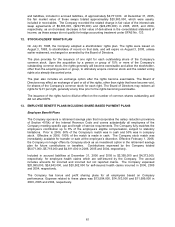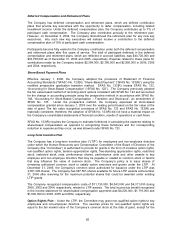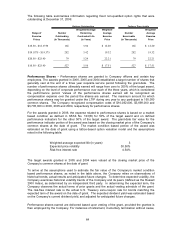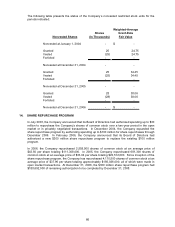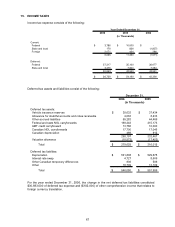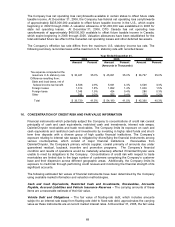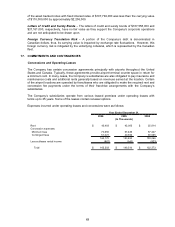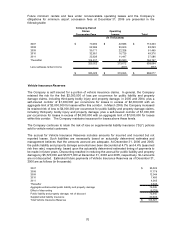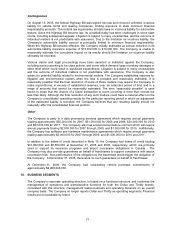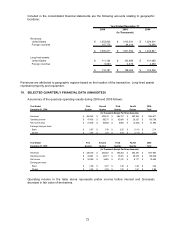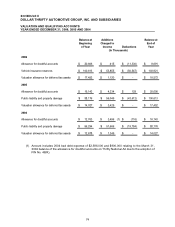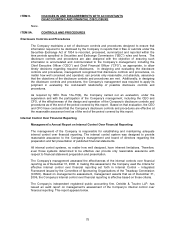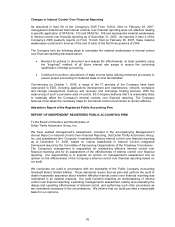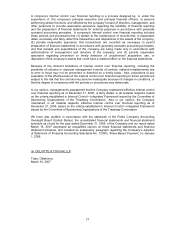Thrifty Car Rental 2006 Annual Report Download - page 74
Download and view the complete annual report
Please find page 74 of the 2006 Thrifty Car Rental annual report below. You can navigate through the pages in the report by either clicking on the pages listed below, or by using the keyword search tool below to find specific information within the annual report.
The Company has net operating loss carryforwards available in certain states to offset future state
taxable income. At December 31, 2006, the Company has federal net operating loss carryforwards
of approximately $435,000,000 available to offset future taxable income in the U.S., which expire
beginning in 2022 through 2024. A valuation allowance of $1,200,000 was established in 2006 for
state net operating losses. At December 31, 2006, DTG Canada has net operating loss
carryforwards of approximately $49,000,000 available to offset future taxable income in Canada,
which expire beginning in 2008 through 2026. Valuation allowances have been established for the
total estimated future tax effect of the Canadian net operating losses and other deferred tax assets.
The Company’s effective tax rate differs from the maximum U.S. statutory income tax rate. The
following summary reconciles taxes at the maximum U.S. statutory rate with recorded taxes:
A
mount Percent
A
mount Percent Amount Percent
(Amounts in Thousands)
Tax expense computed at the
maximum U.S. statutory rate 30,947$ 35.0% 45,691$ 35.0% 36,797$ 35.0%
Difference resulting from:
State and local taxes, net of
federal income tax benefit 2,528 2.9% 5,631 4.3% 3,526 3.3%
Foreign losses 1,614 1.8% 1,892 1.4% 1,606 1.5%
Foreign taxes 1,345 1.5% 424 0.4% 286 0.3%
Other 295 0.3% 552 0.4% 175 0.2%
Total 36,729$ 41.5% 54,190$ 41.5% 42,390$ 40.3%
Year Ended December 31,
2006 2005 2004
16. CONCENTRATION OF CREDIT RISK AND FAIR VALUE INFORMATION
Financial instruments which potentially subject the Company to concentrations of credit risk consist
principally of cash and cash equivalents, restricted cash and investments, interest rate swaps,
DaimlerChrysler receivables and trade receivables. The Company limits its exposure on cash and
cash equivalents and restricted cash and investments by investing in highly rated funds and short-
term time deposits with a diverse group of high quality financial institutions. The Company’s
exposure relating to interest rate swaps is mitigated by diversifying the financial instruments among
various counterparties, which consist of major financial institutions. Receivables from
DaimlerChrysler, the Company's primary vehicle supplier, consist primarily of amounts due under
guaranteed residual, buyback, incentive and promotion programs. The Company’s financial
condition and results of operations would be materially adversely affected if DaimlerChrysler were
unable to meet its obligations to the Company. Concentrations of credit risk with respect to trade
receivables are limited due to the large number of customers comprising the Company’s customer
base and their dispersion across different geographic areas. Additionally, the Company limits its
exposure to credit risk through performing credit reviews and monitoring the financial strength of its
significant accounts.
The following estimated fair values of financial instruments have been determined by the Company
using available market information and valuation methodologies.
Cash and Cash Equivalents, Restricted Cash and Investments, Receivables, Accounts
Payable, Accrued Liabilities and Vehicle Insurance Reserves – The carrying amounts of these
items are a reasonable estimate of their fair value.
Vehicle Debt and Obligations – The fair value of floating-rate debt, which includes amounts
subject to an interest rate swap from floating-rate debt to fixed-rate debt, approximates the carrying
value as these instruments are at current market interest rates. At December 31, 2006, the fair value
68





